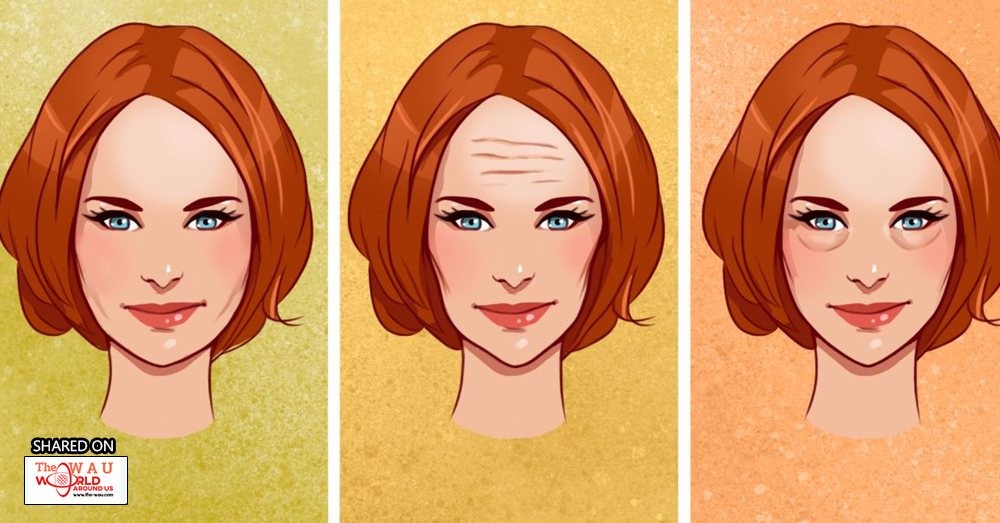Your face can tell you a lot about your health. Most of us see it in the mirror every day – several times a day – but how often do you really look closely at your own face? Your eyes, your skin, your mouth – they all hold important clues about your health.
Next time you notice redness, spots, or dry skin, don’t just try to cover it up with makeup… think about what it might be telling you about your health instead.
1) Your eyes. Health explains that puffy eyes are usually due to a lack of sleep, but can also be caused by diet. If you’re getting plenty of sleep and you still have bags under your eyes, if may be a sign that your diet is too high in sodium. Body and Soul adds that dark circles under the eyes (despite getting enough sleep) can be a result of food intolerance. Common culprits are dairy and wheat – try removing them from the diet and see if the bags under your eyes disappear over time. Alcohol also causes darkness around the eyes. Finally, white spots around the eyes can also be a sign of a lactose intolerance – try removing dairy from your diet if this is the case.
2) Redness. There are many different kinds of rashes that can occur on your face, and if you have a rash that persists for more than a week you should see your doctor. According to Reader’s Digest this can be caused by Coeliac Disease, especially when itchy. A butterfly rash across the cheekbones can be an indicator of an autoimmune disease called lupus, while rosacea can be caused by excessive alcohol consumption.
3) Moles. Usually moles are nothing to worry about, but as with anywhere on your body, you should remember your ABCDE: Asymmetrical, Border, Color, Diameter, and Evolving. Read more about the skin cancer ABCDE here.
4) Dry skin. Dry skin is commonly caused by simple dehydration of the skin – in cold, winter air, for example, or after a hot shower with inadequate moisturizing afterwards. However, if your skin is consistently dry, you might not be drinking enough water. It can also be a sign of allergies, hypothyroidism or diabetes according to Health.
5) Yellow spots around the eyes. These are cholesterol-filled lesions called xanthelasmata, and by themselves are harmless. They can also be removed if they are unsightly. However, Reader’s Digest explains that they are linked to heart issues. A large-scale study in 2011 found that patients with the spots were fifty percent more likely to have a heart attack over the next few decades than those without them.
6) Sores on your mouth. Recurrent sores on your lips or nostrils will usually be cold sores, which are caused by the very contagious Type 1 Herpes virus. Unfortunately, you can never rid yourself of herpes, but you can buy inexpensive medication to combat the cold sores as soon as they develop, which is usually at times of stress or bad health, according to WebMD.
7) Excessive hair. An unusual amount of hair on the face or neck in women can be a sign of polycystic ovary syndrome (PCOS), according to Health. This can cause infertility and unusual periods. If you have excessive hair growth on your face, chest, stomach, or hands, have a chat to your doctor about it.
8) Yellowing skin and eyes. This is called jaundice, and it is surprisingly common. It’s normal and harmless in premature babies, but in adults it can be more of an issue. It is symptomatic of viral infections like hepatitis and mononucleosis, as well as problems with your liver, gallbladder or pancreas, according to WebMD.
9) Skin color. Yellow isn’t the only concerning color change to look out for. Reader’s Digest explains that although some color change is normal (such as going pink after exercise), other changes can be a symptom of health issues. Prolonged paleness can be a sign of anemia, while a bluish tint can be a symptom of heart or lung disease (look out for a bluish tint in your nail beds, too).
10) Bad oral hygiene. If your mouth isn’t looking as healthy as it should, this can have a big effect on the rest of your health too, according to Health. A 2010 study showed that good oral hygiene lowers the risk of heart disease, while those who brush less than twice a day had a 70% greater risk of heart disease.
11) Wrinkles. Wrinkled skin is inevitable in the aging process, but some lifestyle factors can worsen them. Smoking or excessive sun exposure are two major culprits, so ensure that you wear sunblock when you’re in the sun and moisturize daily. Dehydration can also cause premature wrinkles so drink plenty of water. Health also explains that new research shows a link between wrinkles and bone health in women. The greater the wrinkles, the bigger the risk of low bone density.
12) Cracked lips. This is very normal, especially in winter. You can use lip balm to alleviate it, or use a natural product like coconut oil to keep them supple and moisturized. If you have permanently cracked lips, though, you may be dehydrated or allergic to a product you’re using. Finally, it could be a reaction to a drug. If it persists for a number of weeks or is causing you significant discomfort, have a chat to your doctor.
Many people spend a lot of time looking at their face – while putting on makeup or going through their daily beauty routine, for example. But instead of looking at it aesthetically, think about what your face is saying about your health – the clues are all there!
Share This Post















